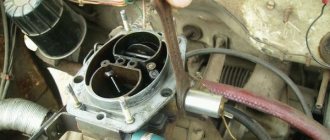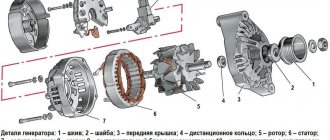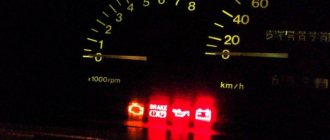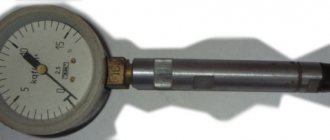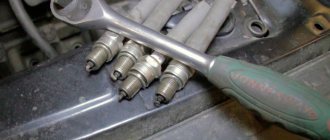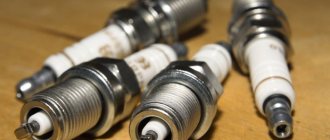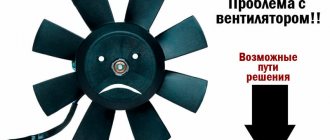What signs indicate a malfunction of the VAZ car distributor?
1. The engine does not start: - there is no gap or too large a gap between the breaker contacts;
-burnt and dirty contacts; - the capacitor has failed; - the noise suppression resistance of the “slider” has burned out; - the distributor cover is “broken”; - the low voltage wire is broken or its terminals are oxidized; -Hall sensor burnt out (non-contact ignition). 2. The engine “shakes” at idle: - the gap between the contacts is not normal;
- ignition too early. 3. The engine “jerks” at high speeds: - the gap between the breaker contacts is too large; - the spring of the movable contact of the breaker has weakened; - the springs of the centrifugal regulator have weakened. 4. “Jerking”, interruptions in all engine modes: -damage to high voltage wires, oxidized or loose in the sockets; -dirty, oily, burnt breaker contacts; - the corner of the moving contact in the distributor cover is worn out or broken; -cracks and burnouts of the “runner” and the distributor cover; - the capacitor is “half broken” and needs to be replaced; - the bushings are worn out and the distributor shaft is “playing”; - the contactless ignition system switch is faulty.
5. The car accelerates slowly, consumes a lot of fuel: -the ignition timing is incorrectly set.
Note! Signs of a malfunction of the VAZ-2107 distributor are very easily confused with manifestations of malfunctions in the power system . Therefore, never start disassembling the distributor and carburetor with the fuel pump at the same time!
The engine jerks, reasons
The engine may jerk when idling or when the vehicle is moving.
The causes of this malfunction are related to the carburetor, fuel system, ignition system or the engine itself (valve, piston, etc.). Let's try to troubleshoot the problem using the example of carburetor engine 21083 of VAZ 21083, 21093, 21099 cars.
Causes of malfunction: engine jerks at idle
Signs of a malfunction: the engine “tweaks” - it runs unevenly at idle. Popping noises are heard in the muffler, repeating at certain intervals.
— The ignition system is faulty
The first thing you should check is the spark plugs. Since one of them may have failed (the insulator is broken, the electrodes are dirty or burnt), which is why the fuel mixture misfires (see photo above).
A similar effect will occur if any high-voltage wire malfunctions, oxidation or destruction of contacts in the voltage wires or contacts in the distributor cover, “broken distributor cover.”
Distributor cover 2108
The engine also jerks if the ignition angle (moment) is set incorrectly or the noise suppression resistor in the cover has failed. We check the condition of the ignition system elements: “Checking the ignition system.”
— Carburetor faulty
The fuel supply through the carburetor idle system to the car engine is disrupted (either too lean or too rich).
The carburetor idle system (jet jets, channels) is clogged. Cleaning the idle system: “Cleaning the idle system.”
Visible elements of the CXX carburetor 2108, 21081, 21083 Solex with the cover removed
The solenoid valve (EMV) may be faulty or incorrectly installed. We check: “Features of installing an EMC.”
The carburetor “overflows” due to a leaky needle shut-off valve, an increased level in the float chamber, or a clogged CXX air jet. In this case, the fuel mixture is over-enriched, floods the spark plugs, the combustion process in the combustion chambers is disrupted, the engine jerks as the cylinders either work or not. Read more: “The carburetor is overfilling, reasons.”
Or there is a “suction” of foreign air into the carburetor, which leans the fuel mixture. See “Air leaking into the carburetor.”
— Car engine is faulty
For example, valves are not adjusted or burnt out. Or the compression in the cylinders is not the same (dispersion among the cylinders is more than 1.5 units).
Causes of the malfunction: the engine jerks when the car is moving
— The engine power supply system is clogged
Failure to supply fuel from the gas tank to the carburetor and then to the engine due to severe clogging of the fuel system (fuel intake in the tank, filters). We check and clean the gas tank and/or fuel system. Pay special attention to cleaning the fuel intake in the gas tank.
The engine jerks due to a clogged filter on the fuel intake
— Elements of the ignition system are “broken”
Malfunction of the ignition system. There may be a problem with current leakage to ground due to a broken distributor cap, slider, ignition coil cover, etc.
— The centrifugal ignition timing regulator is faulty
The weights are stuck, their springs are broken or weakened. Read more: “Checking the centrifugal ignition timing regulator.”
Notes and additions
— Other reasons why a car engine jerks at idle or while driving include the destruction of its supports (pillows).
Other elements of the fuel system
Now on to other elements of the fuel system.
The next culprit for uneven running may be the fuel pump.
In carburetor cars.
A mechanically driven diaphragm fuel pump is often used here.
So, even a small rupture of the membrane will cause the pump’s performance to drop sharply.
The pump valves may also be to blame. They can easily break the sealing of the device’s chambers, which leads to a drop in fuel supply.
The fuel pump can also cause jerking. On such cars, since the pump is located in the tank, it is electrically driven.
A decrease in device performance leads to the problem described in this article. Here you need to consider a specific case separately.
Now directly about the carburetor.
Because of this, uneven running of the car is also possible. Often such a malfunction occurs due to severe clogging. Debris and dirt can block channels, forget jets, etc.
Sometimes the reason lies in the accelerator pump. A diaphragm accelerator pump is installed on carburetors, the task of which is to increase the fuel supply when the gas pedal is sharply pressed.
But if the membrane is torn, then the accelerator pump will not be able to increase the supply of gasoline, and hence fuel starvation.
For injectors, the fuel injectors are checked next. Violation of their performance leads to jerking of the car.
Injectors need to be cleaned periodically, in principle, like everything else.
Also, in an injection car, the functionality of all sensors involved in the operation of the power system is checked, and then the electronic control unit is checked.
The car jerks when moving VAZ 2107 carburetor
Moderator: Rustem
- Go to page:
Unstable engine operation, stalls and jerks
Unread message -sin- » Thu Aug 13, 2009 07:59:53 PM
Unread message NikVE » Fri Aug 14, 2009 7:46:36 AM
Unread message Mr_Ice » Fri Aug 14, 2009 19:06:07
something truly amazing.
For dips, check the needle valve and that the float is not stuck. Next, check the starting device and the integrity of its diaphragm.
about failures during acceleration, check the accelerator pump and, accordingly, its diaphragm.
and of course, what kind of carb? they are different.
Most likely the mixture was very lean
Regarding tripping, look at the ignition and spark plugs
Unread message by VintoreZ » Wed Sep 23, 2009 20:14:14
In short, I once went to a well-promoted carburetor man, whom half the city was praying for, and he got me one!
Added after 4 minutes 36 seconds:
And you need to look at the starting, and it would be advisable to measure the compression, look at the acceleration
failure at low speeds!
Unread message Bolotnik » Fri Jan 08, 2010 16:47:16
Unread message from VintoreZ » Fri Jan 08, 2010 17:00:55
Unread message Bolotnik » Fri Jan 08, 2010 17:16:01
Unread message 34rus » Fri Jan 08, 2010 18:11:45
Unread message Bolotnik » Fri Jan 08, 2010 18:14:29
up to 1500, somewhere around 980-1100 rpm! I press the gas - failure and picks up speed normally!
level of what? I'm new, I don't understand well yet!
Unread message 34rus » Fri Jan 08, 2010 18:18:16
Unread message Bolotnik » Fri Jan 08, 2010 18:21:16
Yes, everything is fine in the carburetor! I did it with my father, he helped!
In general, what does this failure mean? Like I press the gas and it doesn’t have enough air or something? I’ve heard about failures before, but this is my first time!
Unread message 34rus » Fri Jan 08, 2010 18:31:47
Unread message Bolotnik » Sun Jan 10, 2010 11:45:05
Unread message from Zhek » Sun Jan 10, 2010 13:26:50
Unread message Bolotnik » Sun Jan 10, 2010 13:29:44
Unread message from Zhek » Sun Jan 10, 2010 13:40:40
Unread message 34rus » Sun Jan 10, 2010 15:54:07
Unread message Bolotnik » Mon Jan 11, 2010 9:38:08 AM
Dips.
Unread message Serenka » Mon Feb 15, 2010 12:42:51
Good day everyone. VAZ 2107 with Solex carburetor. Help, brothers, when accelerating on my seven, there is a failure, that is, if you go 30 and press the slipper without reaching the floor to catch up to 40 and switch, at the moment you press the pedal a terrible failure begins, the car “stalls” and even sometimes jerks, after a couple seconds it picks up speed easily and easily.
He started swearing at the accelerator pump, took off the roof of the carb, pressed the throttle and observed that the injection was there and normal, he corrected it a little and directed the jet as accurately as possible between the damper and the diffuser. I looked at the same time and set up a shelf in the Murzilka, assembled it, went, gas and failure
The next day I went to the carburetor guy, tinkered, tinkered, scratched my head, he said everything is ok here, your ignition is probably stuck, but I heard that the switch on the BSZ can also create such a failure, changed the 0 effect, at the same time changed the distributor and the coil and the switch wires .
I changed the fuel pump when the old one died, the dipstick was almost up to the handle in oil, I went and quickly washed it with a flusher, filled in fresh oil, the pump pumped, now there are two more questions: how does the carb allow the pump to overflow? and should I change the pump again? And where is the guarantee that the new pump will not overflow again? I bought and installed a new DAAZ pump.
The car jerks when driving
A malfunction such as a VAZ 2107 jerking while driving and during acceleration does not so much make the driver think as annoying, and even “infuriating”. Moreover, if, after stopping and getting out of the car, the driver opens the hood and nothing is found there. Therefore, you should listen to how the car behaves while driving. The following options are possible:
- The car jerks when accelerating;
- The VAZ 2107 jerks at a constant speed and the gas pedal is pressed steadily;
- The car jerks when the clutch is engaged;
- The car jerks when the brakes are applied.
Failure in the ignition system
If no problem is found in the fuel supply system, you should look for it further - in the ignition system.
The first thing you should always do is check that the distributor is working properly. The quality of contacts and those responsible for supplying high-voltage pulses to the spark plugs. If these contacts burn, the operation of the motor may be disrupted and an effect may occur when the engine triples or doubles. If everything is fine with the distributor, you need to check the condition of the high-voltage wires on the spark plugs. In the event of an insulation breakdown, they can have this effect.
Separately, it is worth diagnosing the ignition coil and its wires. In some cases, the problem may be located there.
In very rare cases, it happens that a spark plug, which can be said to be “on its last legs,” can produce a spark in a chaotic manner, which also negatively affects the operation of the engine.
For engines with an injector, the causes of malfunctions may be identical to those for carburetor engines. And eliminating these problems is done in the same way. In addition to possible malfunctions in the electronic components of the injector. Then you cannot do without accurate diagnostics of all electronics.
When the car jerks when braking, pressing or releasing the clutch pedal, this indicates possible wear or damage in these systems. These defects are eliminated through inspection and revision.
Malfunctions of the carburetor and other systems
The second most popular system that fails in the VAZ-2107 is the carburetor.
- First of all, check the idle air valve and jets. The valve needs to be replaced and the jets cleaned. Buy only high quality components so that they do not break down quickly.
- The second common malfunction of the carburetor unit is air getting into it. The place where it is sucked in can be found by visually inspecting the hoses. Most often, the thin hose of the vacuum corrector loses its seal. Many technicians recommend simply replacing all the hoses, since air can enter the carburetor through microcracks.
After checking the fuel system and carburetor, you need to pay attention to the distributor. Be sure to check the quality of the ignition contacts that distribute the impulse to the spark plugs
If the contact burns out, the engine will “triple”, “double”, and jerking will be felt while driving.
If you do not find a malfunction here, then check the spark plug wires. Experts recommend changing them, like carburetor hoses, at the slightest suspicion. Usually the problem is hidden in insulation breakdowns, which may not be visible to the naked eye.
When inspecting and checking the wires, pay attention to the ignition coil and its wire
In the rarest cases, the car may move jerkily due to the spark plug failing soon. Typically, this behavior is unusual for this element of the ignition system, but car mechanics sometimes encounter this problem. The fact is that before failure, the spark plug begins to spark randomly, creating failures in ignition. The engine reacts to this with jerks and uneven running. Modern spark plugs most often do not behave this way; spark problems occur with inexpensive options with low quality.
Characters without spaces – 4468
Uniqueness of ETHT – 98%
Uniqueness of Text.ru – 100%
Academic nausea Advego–7.5%
Advego word frequency – 1.61%
There is a special offer on our website. You can get a free consultation with our corporate lawyer by simply submitting your question in the form below.
The car is shaking, what should I do?
At the first stage, the machine is diagnosed. Let's say that you have a VAZ 2106 with a carburetor engine in your garage. Your car already shows signs of “illness” at the first stage of movement. Or the car started moving without any hassle, but when a certain number of revolutions was reached, the engine malfunctioned. All this will not give answers, but only creates questions, because anything can break. In any case, if unstable operation of the car’s power unit is noticed while pressing the accelerator pedal, the first thing you should do is:
- Check air and fuel filters. The supply of air and fuel to form a combustible mixture will be difficult if these elements are heavily contaminated.
- Check the fuel pump. Its incorrect operation leads to unstable fuel supply.
- Check fuel pressure. The supply of the fuel-air mixture under insufficient pressure often leads to jerking of the car. The pressure when the engine is running should not exceed 3 kgf/cm2.
Most of the reasons lie in the car's fuel system. But you shouldn’t write off the ignition system, and sometimes even the transmission can cause discomfort while driving. There can be many reasons. To narrow your suspicions, measure the conditions during which the car begins to act up. To do this, while driving, watch the instrument panel and remember at what moment the uniform movement stopped. Do this several times to confirm that your observation is correct.
Idling
A common phenomenon is floating idle speed when operating on gas; this occurs quite often after a recent change of injectors in the LPG system. And the fact that after replacing the injectors with new ones the car drove well for some time only confirms that this is precisely the problem. Or more precisely, the need for additional calibration of new injectors after the car has driven one to two thousand kilometers. If your problem is the unstable operation of the car at idle, after recently replacing the injectors, be sure to contact a specialist who will calibrate and configure the system.
Why does the car jerk while driving?
The situation when a car starts to move unevenly is familiar to every motorist. The problem, which manifests itself in jerking and jerking, can be caused by the incorrect operation of various automotive systems. Today we will look at the common symptoms of this “disease” and share recommendations for eliminating them.
So, a violation of the smoothness of the ride and the associated jerks of the car occur:
- when starting off;
- during acceleration;
- at low speeds;
- when the engine is operating at maximum load;
- in transient conditions;
- in all of the above cases.
Determining the culprit of the malfunction
The car can “twitch” while driving for various reasons, so you should adhere to a certain troubleshooting algorithm. If there are no obvious signs of transmission malfunction, then first of all we check the power and ignition system.
Failures in the engine power system
Malfunctions in the system for preparing and supplying the fuel mixture are indicated by jerking of the machine in motion. In this case, the malfunction can manifest itself in different ways:
- The car begins to twitch when the accelerator pedal is pressed sharply. At the same time, instead of gaining speed, the engine runs jerkily, and therefore the car picks up speed very reluctantly. At some stage, the twitching stops and the engine “picks up.” In other cases, the power unit stalls when the throttle is maximally open, or jerking occurs when the gas is released.
- The unevenness of the ride appears unexpectedly - when the car is moving at a constant speed, in a stable speed mode.
As you can see, uneven engine operation can appear both when the crankshaft speed changes sharply or smoothly in one direction or another, or when operating at stable speeds. The reason for these phenomena is a simple lack of combustible mixture, due to which the engine simply cannot develop power sufficient to overcome the resistance of the transmission.
To eliminate negative phenomena, we check several main components of the power system:
1. Filter. Even with a working fuel pump and a clean fuel line, the engine will begin to starve if the fuel filter is clogged with dirt. The way out is to replace or clean the filter element - it all depends on where exactly the blockage occurred. The fact is that car engines have several cleaning elements installed along the fuel path. If you are dealing with an injection internal combustion engine, then you should pay attention to the third filter element located after the fuel pump. Designed to separate the smallest particles, it clogs quite often, which is why the gas pump cannot pump the required volume of fuel through it. For carburetor cars, we check both the third filter installed in front of the carburetor, and the second one - it is located between the fuel tank and the fuel pump. If replacing them did not yield anything, then you should check the coarse filter installed on the fuel receiver. In addition, the cause of insufficient fuel supply may be the mesh located in front of the float chamber in the carburetor body.
2. Throttle assembly . Malfunctions in the throttle can be caused by wear and damage to its parts and contamination. And if the first requires serious repairs, then in the second case, simple cleaning of the throttle assembly elements mechanically will help. In the case of carburetor internal combustion engines, the situation is more complicated, because you will have to completely disassemble the carburetor and clean all channels, jets, diffusers, etc.
Why does the VAZ 2107 jerk?
When the driver discovers that the VAZ 2107 car is twitching, first of all there is a feeling of wariness and, of course, this is terribly annoying.
Usually, a visual inspection of the engine does not bring any results. To identify the cause, it is necessary to determine under what conditions the car jerks.
The most common options are:
- the car starts to jerk and stalls when accelerating;
- the car jerks when you press the clutch pedal;
- during braking;
- at speed with the accelerometer pedal pressed.
If the VAZ 2107 car jerks periodically in the 2nd and 3rd cases, then you need to pay attention to the operation of the clutch and its condition. Other cases may be harbingers of a wide variety of malfunctions
In what cases is a car “jerking” detected?
Most cases of car “jerking” are associated with problems with wear of spare parts or clogging of one of the car’s systems. While driving, you can detect vehicle twitching at the following stages:
- When starting only at the beginning of the car's movement;
- When driving at low speeds;
- During a sudden increase in speed;
- When driving at high speed;
- When driving in any mode (periodic shocks at different periods of time).
Consider the case of a vehicle malfunction when driving at low speeds.
